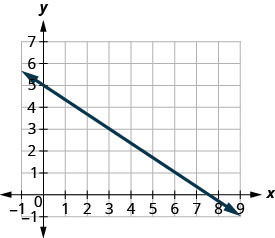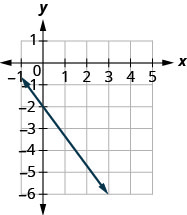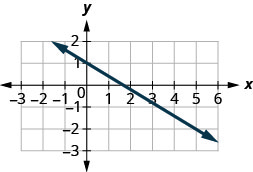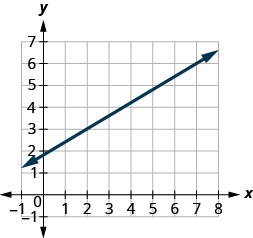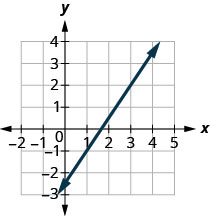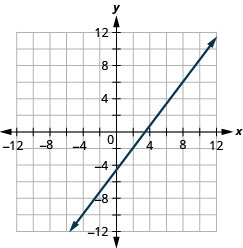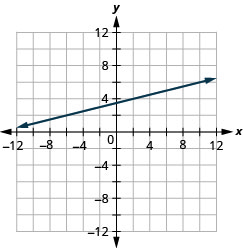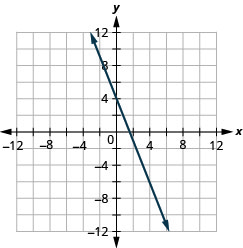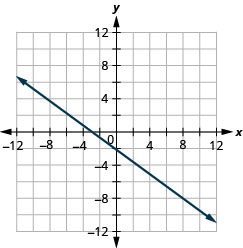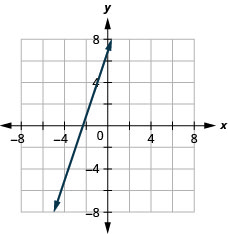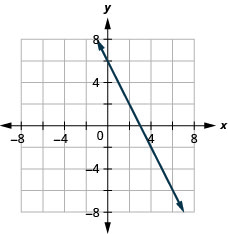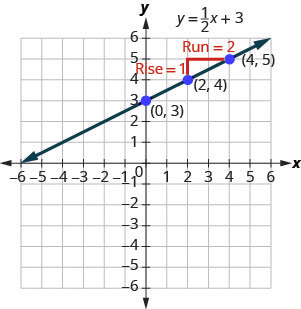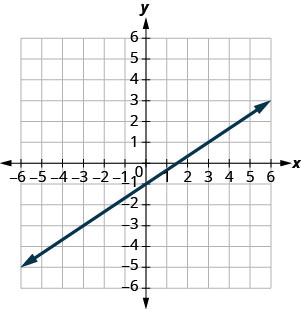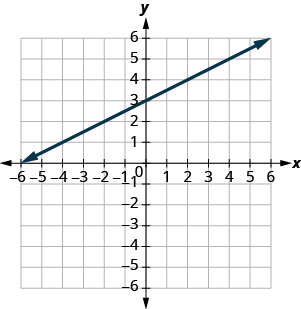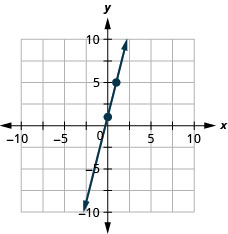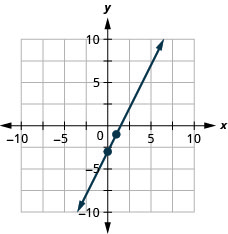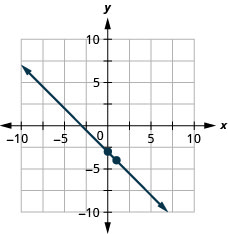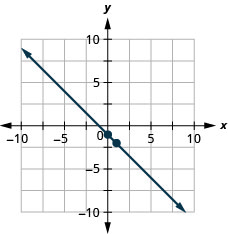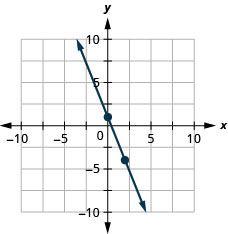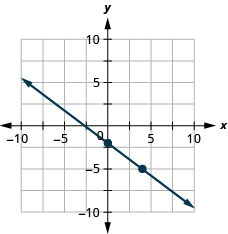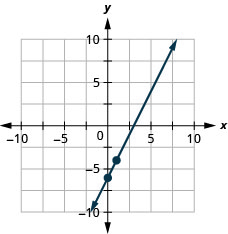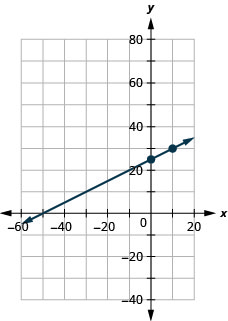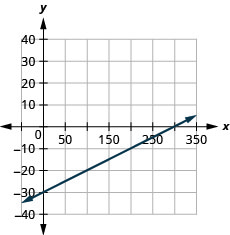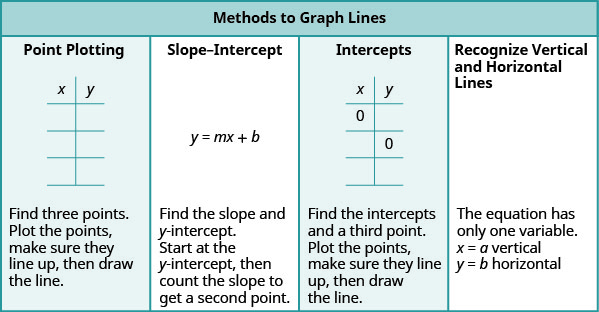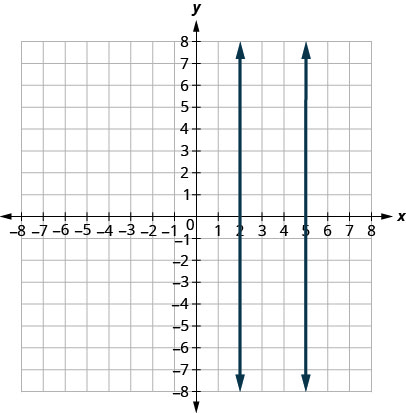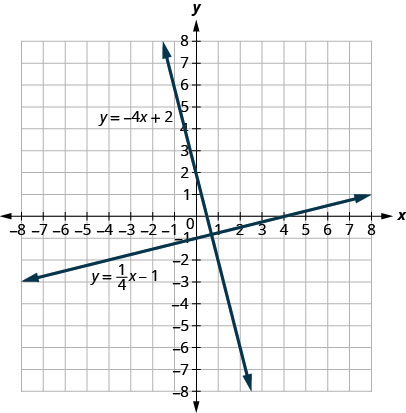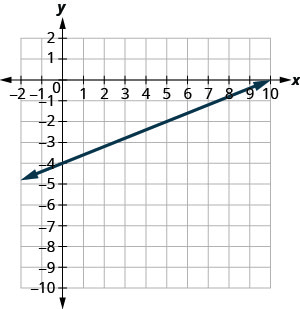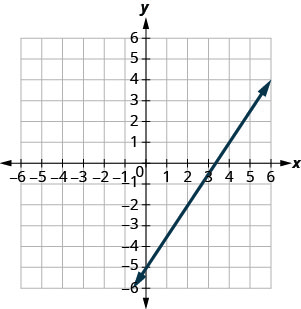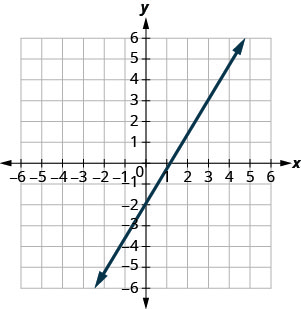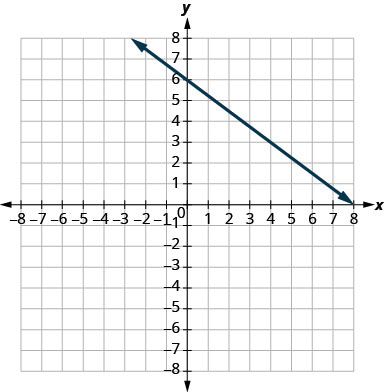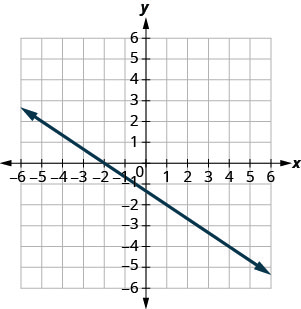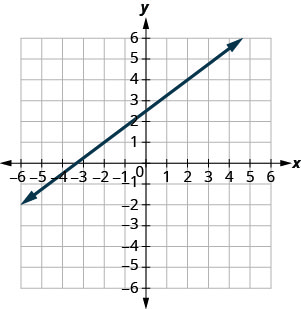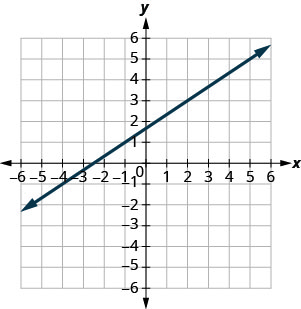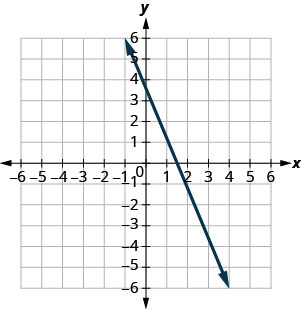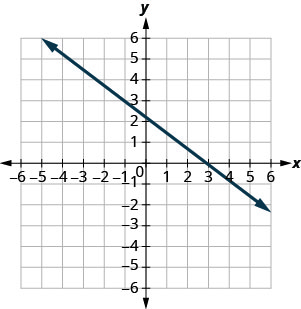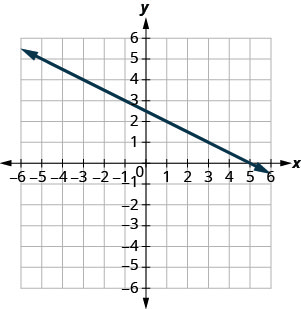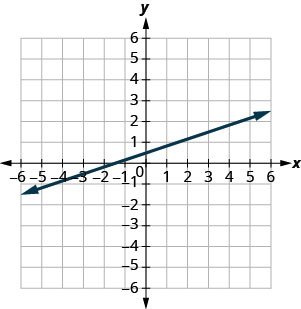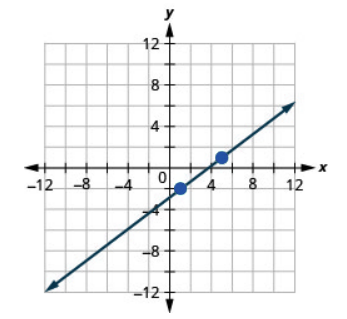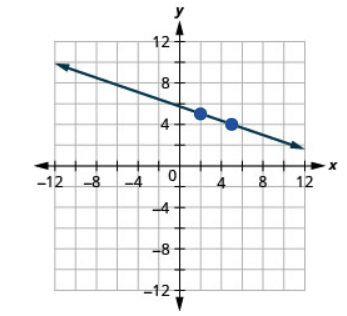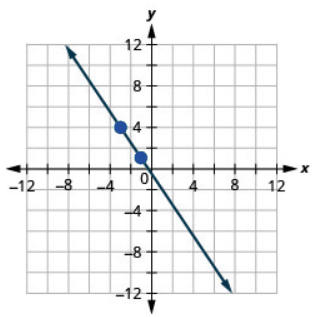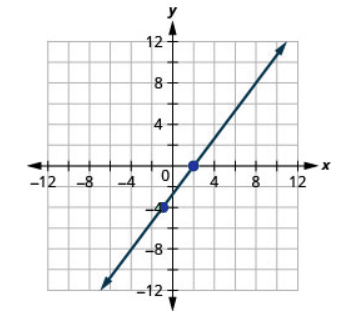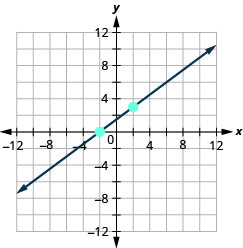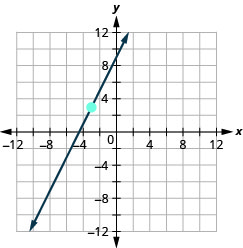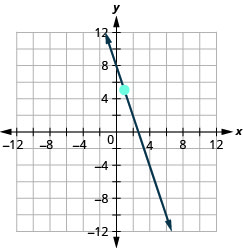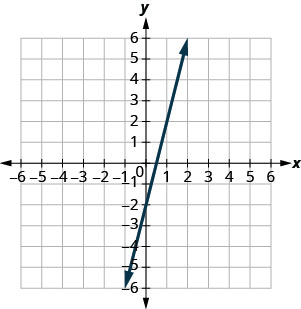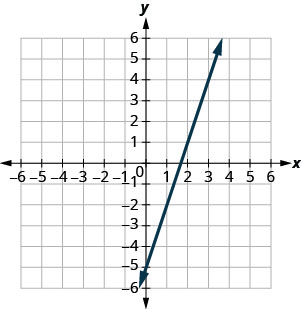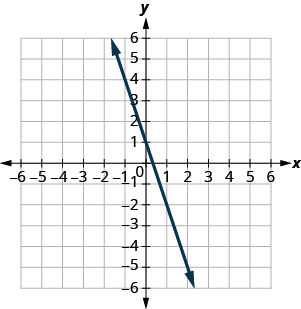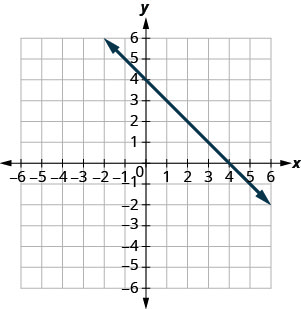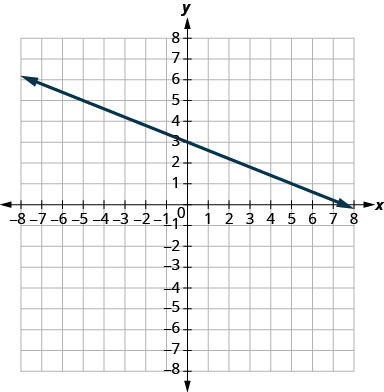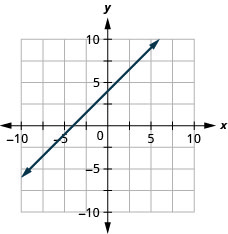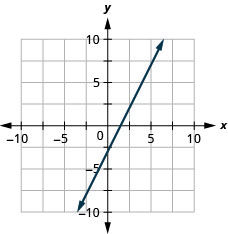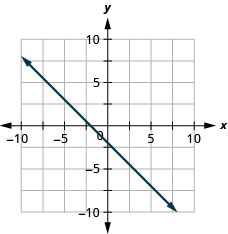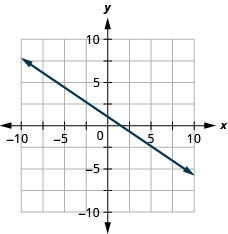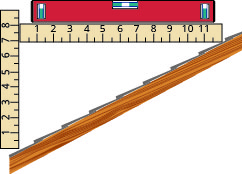3.10 Slope of a Line
Learning Objectives
By the end of this section, you will be able to:
- Use [latex]m=\frac{rise}{run}[/latex] to find the slope of a line from its graph
- Find the slope of horizontal and vertical lines
- Use the slope formula to find the slope of a line between two points
- Graph a line given a point and the slope
- Solve slope applications
- Recognize the relation between the graph and the slope–intercept form of an equation of a line
- Identify the slope and [latex]y[/latex]-intercept form of an equation of a line
- Graph a line using its slope and intercept
- Choose the most convenient method to graph a line
- Graph and interpret applications of slope–intercept
- Use slopes to identify parallel lines
- Use slopes to identify perpendicular lines
Try It
Before you get started, take this readiness quiz:
1) Simplify: [latex]\frac{1–4}{8-2}[/latex]
2) Divide: [latex]\frac{0}{4},\frac{4}{0}[/latex]
3) Simplify: [latex]\frac{15}{-3},\frac{-15}{3},\frac{-15}{-3}[/latex]
4) Add: [latex]\frac{x}{4}+\frac{1}{4}[/latex]
5) Find the reciprocal of [latex]\frac{3}{7}[/latex]
6) Solve [latex]2x-3y=12[/latex]
When you graph linear equations, you may notice that some lines tilt up as they go from left to right and some lines tilt down. Some lines are very steep and some lines are flatter. What determines whether a line tilts up or down or if it is steep or flat?
In mathematics, the ‘tilt’ of a line is called the slope of the line. The concept of slope has many applications in the real world. The pitch of a roof, the grade of a highway, and a ramp for a wheelchair are some examples where you see slopes. And when you ride a bicycle, you feel the slope as you pump uphill or coast downhill.
In this section, we will explore the concept of slope.
Use [latex]m=\frac{rise}{run}[/latex] to Find the Slope of a Line from its Graph
Now, we’ll look at some graphs on the [latex]xy[/latex]-coordinate plane and see how to find their slopes. The method we will use here will be similar to how one would use geoboards.
To find the slope, we must count out the rise and the run. But where do we start?
We locate two points on the line whose coordinates are integers. We then start with the point on the left and sketch a right triangle, so we can count the rise and run.
How to
Find the slope of a line from its graph using [latex]m=\frac{rise}{run}[/latex]
- Locate two points on the line whose coordinates are integers.
- Starting with the point on the left, sketch a right triangle, going from the first point to the second point.
- Count the rise and the run on the legs of the triangle.
- Take the ratio of rise to run to find the slope, [latex]m=\frac{rise}{run}[/latex]
Example 1
Solution
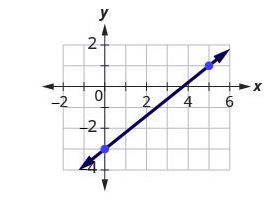
Step 1: Locate two points whose coordinates are integers.
Mark [latex](0-,3)(5,1)[/latex]
Step 2: Starting with the point on the left, sketch a right triangle, going from the first point to the second point.
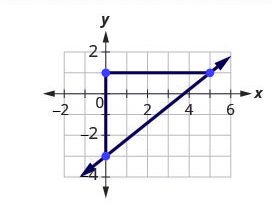
Step 3: Count the rise and the run on the legs of the triangle.
Count the rise.
Count the run.
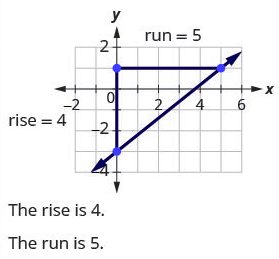
Step 4: Take the ratio of rise to run to find the slope.
[latex]\begin{align*} &\text{Use the slope formula.}\;&m&=\frac{rise}{run}\\ &\text{Substitute the values of the rise and run.}\;&m&=\frac45\end{align*}[/latex]
The slope of the line is [latex]\frac45[/latex].
Example 2
Solution
[latex] m=\frac{rise}{run}[/latex]
Step 1. Locate two points on the graph whose coordinates are integers.
[latex](0,5)[/latex] and [latex](3,3)[/latex]
Step 2: Which point is on the left?
[latex](0,5)[/latex]
Step 3: Starting at [latex](0,5)[/latex], sketch a right triangle to [latex](3,3)[/latex].
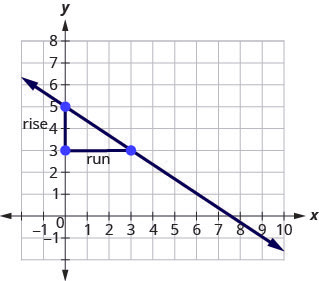
Step 4: Count the rise—it is negative.
The rise is [latex]-2[/latex].
Step 5: Count the run.
The run is [latex]3[/latex].
Step 6: Use the slope formula.
[latex]m=\frac{rise}{run}[/latex]
Step 7: Substitute the values of the rise and run.
[latex]\begin{align*}&\;&m&=\frac{-2}{3}\\&\text{Simplify.}\;&m&=-\frac{2}{3}\end{align*}[/latex]
The slope of the line is [latex]-\frac{2}{3}[/latex].
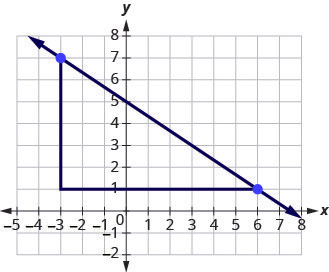
So y increases by [latex]3[/latex] units as [latex]x[/latex] decreases by [latex]2[/latex] units. What if we used the points left [latex](-3,7)[/latex] and [latex](6,1)[/latex] to find the slope of the line? The rise would be [latex]-6[/latex] and the run would be [latex]9[/latex]. Then [latex]m=\frac{-6}{9}[/latex], and that simplifies to [latex]m=-\frac{2}{3}[/latex]. Remember, it does not matter which points you use—the slope of the line is always the same.
Try It
In the last two examples, the lines had [latex]y[/latex]-intercepts with integer values, so it was convenient to use the [latex]y[/latex]-intercept as one of the points to find the slope. In the next example, the [latex]y[/latex]-intercept is a fraction. Instead of using that point, we’ll look for two other points whose coordinates are integers. This will make the slope calculations easier.
Example 3
Solution
Step 1: Locate two points on the graph whose coordinates are integers.
[latex](2,3)[/latex] and [latex](7,6)[/latex]
Step 2: Which point is on the left?
[latex](2,3)[/latex]
Step 3: Starting at [latex](2,3)[/latex], sketch a right triangle to [latex](7,6)[/latex].
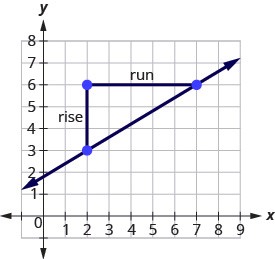
Step 4: Count the rise.
The rise is [latex]3[/latex].
Step 5: Count the run.
The run is [latex]5[/latex].
Step 6: Use the slope formula.
[latex]m=\frac{rise}{run}[/latex]
Step 7: Substitute the values of the rise and run.
The slope of the line is [latex]\frac{3}{5}[/latex]
This means that [latex]y[/latex] increases [latex]5[/latex] units as [latex]x[/latex] increases [latex]3[/latex] units. If you used a geoboard to introduce the concept of slope, you would always start with the point on the left and count the rise and the run to get to the point on the right. That way the run was always positive and the rise determined whether the slope was positive or negative. What would happen if we started with the point on the right? Let’s use the points [latex](2,3)[/latex] and [latex](7,6)[/latex] again, but now we’ll start at [latex](7,6)[/latex].
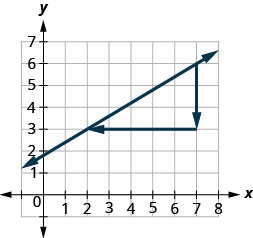
Step 1: Count the rise.
The rise is [latex]-3[/latex].
Step 2: Count the run. It goes from right to left, so it is negative.
The run is [latex]-5[/latex].
Step 3: Use the slope formula.
[latex]m=\frac{rise}{run}[/latex]
Step 4: Substitute the values of the rise and run.
[latex]m=\frac{-3}{-5}[/latex]
Step 5: The slope of the line is [latex]\frac{3}{5}[/latex].
It does not matter where you start—the slope of the line is always the same.
Do you remember what was special about horizontal and vertical lines? Their equations had just one variable.
| Horizontal line [latex]y = b[/latex] | Vertical line [latex]x = a[/latex] |
| [latex]y[/latex]-coordinates are the same. | [latex]x[/latex]-coordinates are the same. |
So how do we find the slope of the horizontal line [latex]y=4[/latex]? One approach would be to graph the horizontal line, find two points on it, and count the rise and the run. Let’s see what happens when we do this.

Step 1: What is the rise?
The rise is [latex]0[/latex].
Step 2: Count the run.
The run is [latex]3[/latex].
Step 3: What is the slope?
[latex]\begin{align*}m&=\frac{rise}{run}\\m&=\frac{0}{3}\\m&=0\end{align*}[/latex]
The slope of the horizontal line [latex]y=4[/latex] is [latex]0[/latex].
All horizontal lines have slope [latex]0[/latex]. When the [latex]y[/latex]-coordinates are the same, the rise is [latex]0[/latex].
Slope of a Horizontal Line
The slope of a horizontal line, [latex]y=b[/latex], is [latex]0[/latex].
The floor of your room is horizontal. Its slope is [latex]0[/latex]. If you carefully placed a ball on the floor, it would not roll away.
Now, we’ll consider a vertical line, the line.
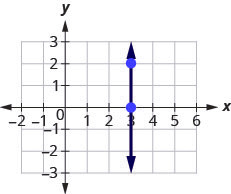
Step 1: What is the rise?
The rise is [latex]2[/latex].
Step 2: Count the run.
The run is [latex]0[/latex].
Step 3: What is the slope?
[latex]\begin{align*}m&=\frac{rise}{run}\\m&=\frac{2}{0}\end{align*}[/latex]
But we can’t divide by [latex]0[/latex]. Division by [latex]0[/latex] is not defined. So we say that the slope of the vertical line [latex]x=3[/latex] is undefined.
The slope of any vertical line is undefined. When the [latex]x[/latex]-coordinates of a line are all the same, the run is [latex]0[/latex].
The slope of a Vertical Line
The slope of a vertical line, [latex]x=a[/latex], is undefined.
Example 4
Find the slope of each line:
a. [latex]x=8[/latex]
b. [latex]y=-5[/latex]
Solution
a. [latex]x=8[/latex]
This is a vertical line.
Its slope is undefined.
b. [latex]y=-5[/latex]
This is a horizontal line.
It has slope [latex]0[/latex].
Try It
13) Find the slope of the line: [latex]x=-4[/latex].
Solution
undefined
14) Find the slope of the line: [latex]y=7[/latex].
Solution
[latex]0[/latex]
Use the Slope Formula to find the Slope of a Line Between Two Points
Sometimes we’ll need to find the slope of a line between two points when we don’t have a graph to count out the rise and the run. We could plot the points on grid paper, and then count out the rise and the run, but as we’ll see, there is a way to find the slope without graphing. Before we get to it, we need to introduce some algebraic notation.
We have seen that an ordered pair [latex](x,y)[/latex] gives the coordinates of a point. But when we work with slopes, we use two points. How can the same symbol [latex](x,y)[/latex] be used to represent two different points? Mathematicians use subscripts to distinguish the points.
| [latex](x_1,y_1)[/latex] | read ' [latex]x[/latex] sub 1, [latex]y[/latex] sub 1 ' |
| [latex](x_2,y_2)[/latex] | read ' [latex]x[/latex] sub 2, [latex]y[/latex] sub 2 ' |
The use of subscripts in math is very much like the use of last name initials in elementary school. Maybe you remember Laura C. and Laura M. in your third grade class?
We will use [latex](x_1,y_1)[/latex] to identify the first point and [latex](x_2,y_2)[/latex] to identify the second point.
If we had more than two points, we could use [latex](x_3,y_3)[/latex], [latex](x_4,y_4)[/latex], and so on.
Let’s see how the rise and run are related to the coordinates of the two points by taking another look at the slope of the line between the points [latex](2,3)[/latex] and [latex](7,6)[/latex].
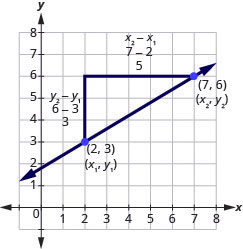
Since we have two points, we will use subscript notation,
[latex]\begin{pmatrix}x_1&y_1\\2&3\end{pmatrix}[/latex] [latex]\begin{pmatrix}x_2&y_2\\7&6\end{pmatrix}[/latex]
On the graph, we counted the rise of [latex]3[/latex] and the run of [latex]5[/latex].
Notice that the rise of [latex]3[/latex] can be found by subtracting the [latex]y[/latex]-coordinates [latex]6[/latex] and [latex]3[/latex].
And the run of [latex]5[/latex] can be found by subtracting the [latex]x[/latex]-coordinates [latex]7[/latex] and [latex]2[/latex].
We know [latex]m=\frac{rise}{run}[/latex]. So [latex]m=\frac{3}{5}[/latex].
We rewrite the rise and run by putting in the coordinates [latex]m=\frac{6-3}{7-2}[/latex].
But [latex]6[/latex] is [latex]y_2[/latex], the [latex]y[/latex]-coordinate of the second point and [latex]3[/latex] is [latex]y_1[/latex] the [latex]y[/latex]-coordinate of the first point.
So we can rewrite the slope using subscript notation. [latex]m=\frac{y_2-y_1}{7-2}[/latex]
Also, [latex]7[/latex] is [latex]x_2[/latex], the [latex]x[/latex]-coordinate of the second point and [latex]2[/latex] is [latex]x_1[/latex], the [latex]x[/latex]-coordinate of the first point.
So, again, we rewrite the slope using subscript notation. [latex]m=\frac{y_2-y_1}{x_2-x_1}[/latex]
We’ve shown that [latex]m=\frac{y_2-y_1}{x_2-x_1}[/latex] is really another version of [latex]m=\frac{rise}{run}[/latex]. We can use this formula to find the slope of a line when we have two points on the line.
Slope Formula
The slope of the line between two points [latex](x_1,y_1)[/latex] and [latex](x_2,y_2)[/latex] is
This is the slope formula.
The slope is:
over
[latex]x[/latex] of the second points minus [latex]x[/latex] of the first point
Example 5
Use the slope formula to find the slope of the line between the points [latex](1,2)[/latex] and [latex](4,5)[/latex].
Solution
[latex]m=\frac{y_2-y_1}{x_2-x_1}[/latex]
Step 1: We'll call [latex](1,2)[/latex] point #1 and [latex](4,5)[/latex] point #2.
[latex]\begin{pmatrix}x_1&y_1\\1&2\end{pmatrix}[/latex] [latex]\begin{pmatrix}x_2&y_2\\4&5\end{pmatrix}[/latex]
Step 2: Use the slope formula.
[latex]m=\frac{rise}{run}[/latex]
Step 3: Substitute the values.
[latex]y[/latex] of the second point minus [latex]y[/latex] of the first point.
[latex]m=\frac{5-2}{x_2-x_1}[/latex]
[latex]x[/latex] of the second point minus [latex]x[/latex] of the first point.
[latex]m=\frac{5-2}{4-1}[/latex]
Step 4: Simplify the numerator and the denominator.
[latex]\begin{align*} &\;&m&=\frac33\\ &\text{Simplify.}&m&=1 \end{align*}[/latex]
Let’s confirm this by counting out the slope on a graph using [latex]m=\frac{rise}{run}[/latex].

It doesn’t matter which point you call point #1 and which one you call point #2. The slope will be the same. Try the calculation yourself.
Try It
15) Use the slope formula to find the slope of the line through the points: [latex](8,5)[/latex] and [latex](6,3)[/latex].
Solution
[latex]1[/latex]
16) Use the slope formula to find the slope of the line through the points: [latex](1,5)[/latex] and [latex](5,9)[/latex].
Solution
[latex]1[/latex]
Example 6
Use the slope formula to find the slope of the line through the points [latex](-2,-3)[/latex] and [latex](-7,4)[/latex].
Solution
Step 1. We'll call [latex](-2,-3)[/latex] point #1 and [latex](-7,4)[/latex] point #2.
[latex]\begin{pmatrix}x_1&y_1\\-2&-3\end{pmatrix}[/latex] [latex]\begin{pmatrix}x_2&y_2\\-7&4\end{pmatrix}[/latex]
Step 2. Use the slope formula.
[latex]m=\frac{y_2-y_1}{x_2-x_1}[/latex]
Step 3. Substitute the values.
[latex]y[/latex] of the second point minus [latex]y[/latex] of the first point.
[latex]m=\frac{4-(-3)}{x_2-x_1}[/latex]
[latex]x[/latex] of the second point minus [latex]x[/latex] of the first point.
[latex]m=\frac{4-(-3)}{-7-(-2)}[/latex]
Step 4. Simplify.
[latex]\begin{align*}m&=\frac{7}{-5}\\m&=-\frac{7}{5}\end{align*}[/latex]
Let’s verify this slope on the graph shown.
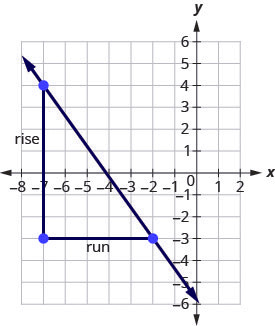
Try It
17) Use the slope formula to find the slope of the line through the points: [latex](-3,4)[/latex] and [latex](2,-1)[/latex]
Solution
[latex]-1[/latex]
18) Use the slope formula to find the slope of the line through the pair of points: [latex](-2,6)[/latex] and [latex](-3,-4)[/latex].
Solution
[latex]10[/latex]
Graph a Line Given a Point and the Slope
Up to now, in this chapter, we have graphed lines by plotting points, by using intercepts, and by recognizing horizontal and vertical lines.
One other method we can use to graph lines is called the point-slope method. We will use this method when we know one point and the slope of the line. We will start by plotting the point and then use the definition of slope to draw the graph of the line.
How to
Graph a line given a point and the slope.
- Plot the given point.
- Use the slope formula [latex]m=\frac{rise}{run}[/latex] to identify the rise and the run.
- Starting at the given point, count out the rise and run to mark the second point.
- Connect the points with a line.
Example 7
Graph the line passing through the point [latex](1,-1)[/latex] whose slope is [latex]m=\frac{3}{4}[/latex].
Solution
Step 1: Plot the given point.
Plot [latex](1,-1)[/latex].
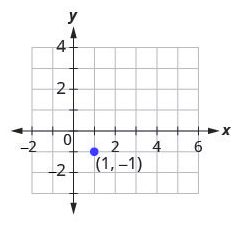
Step 2: Use the slope formula [latex]m=\frac{rise}{run}[/latex] to identify the rise and the run.
Identify the rise and the run.
[latex]\begin{align*}m&=\frac34\\[2ex]\frac{rise}{run}&=\frac34\\[3ex]\text{rise}&=3\\\text{run}&=4\end{align*}[/latex]
Step 3: Starting at the given point, count out the rise and run to mark the second point
Start at [latex](1,-1)[/latex] and count the rise and the run. Up [latex]3[/latex] units, right [latex]4[/latex] units.

Step 4: Connect the points with a line.
Connect the two points with a line.

Example 8
Solution
Step 1: Plot the given point, the [latex]y[/latex]-intercept, [latex](0,2)[/latex].

[latex]m=-\frac{2}{3}[/latex]
Step 2: Identify the rise and the run.
[latex]\begin{align*}\left(\frac{rise}{run}\right)&=\frac{-2}{3}\\rise&=-2\\run&=3\end{align*}[/latex]
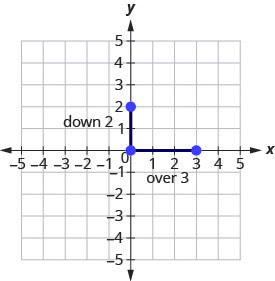
Step 3: Count the rise and the run. Mark the second point.
Step 4: Connect the two points with a line.
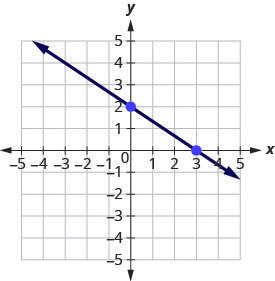
You can check your work by finding a third point. Since the slope is [latex]m=-\frac{2}{3}[/latex], it can be written as [latex]m=\frac{2}{-3}[/latex]. Go back to [latex](0,2)[/latex] and count out the rise, [latex]2[/latex], and the run, [latex]-3[/latex]
Example 9
Graph the line passing through the point [latex](-1,-3)[/latex] whose slope is [latex]m=4[/latex].
Solution
Step 1: Plot the given point.
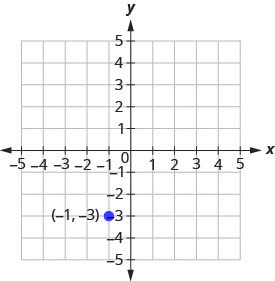
Step 2: Identify the rise and the run.
[latex]m=4[/latex]
Step 3: Write [latex]4[/latex] as a fraction.
[latex]\begin{align*}\frac{rise}{run}&=\frac{4}{1}\\rise&=4\\run&=1\end{align*}[/latex]
Step 4: Count the rise and run and mark the second point.
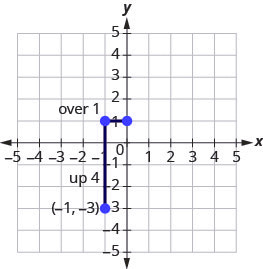
Step 5: Connect the two points with a line.
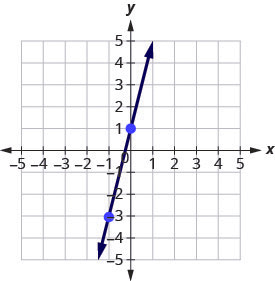
You can check your work by finding a third point. Since the slope is [latex]m=4[/latex], it can be written as [latex]m=\frac{-4}{-1}[/latex]. Go back to [latex](-1,-3)[/latex] and count out the rise, [latex]-4[/latex], and the run, [latex]-1[/latex].
At the beginning of this section, we said there are many applications of slope in the real world. Let’s look at a few now.
Example 10
The ‘pitch’ of a building’s roof is the slope of the roof. Knowing the pitch is important in climates where there is heavy snowfall. If the roof is too flat, the weight of the snow may cause it to collapse. What is the slope of the roof shown?
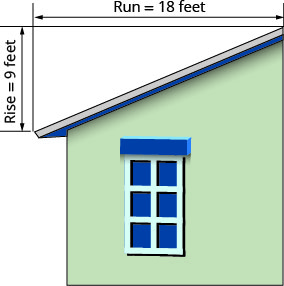
Solution
Step 1: Use the slope formula.
[latex]m=\frac{rise}{run}[/latex]
Step 2: Substitute the values for rise and run.
[latex]m=\frac{9}{18}[/latex]
Step 3: Simplify.
[latex]m=\frac{1}{2}[/latex]
Step 4: The slope of the roof is [latex]\frac{1}{2}[/latex].
The roof rises [latex]1[/latex] foot for every [latex]2[/latex] feet of horizontal run.
Try It
25) Use Example 3.10.10, substituting the [latex]rise = 14[/latex] and [latex]run = 24[/latex].
Solution
[latex]\frac{7}{12}[/latex]
26) Use Example 3.10.10, substituting [latex]rise = 15[/latex] and [latex]run = 36[/latex].
Solution
[latex]\frac{5}{12}[/latex]
Example 11
Have you ever thought about the sewage pipes going from your house to the street? They must slope down [latex]\frac{1}{4}[/latex] inch per foot in order to drain properly. What is the required slope?

Solution
Step 1: Use the slope formula
[latex]\begin{align*} &\;&m&=\frac{rise}{run}\\[2ex] &\;&m&=\frac{-\frac14inch}{1\;foot}\\[2ex] &\;&m&=\frac{-\frac14inch}{12\;inches}\\[2ex] &\text{Simplify.}&m&=-\frac1{48} \end{align*}[/latex]
The slope of the pipe is [latex]-\frac{1}{48}[/latex]
The pipe drops [latex]1[/latex] inch for every [latex]48[/latex] inches of horizontal run.
Try It
27) Find the slope of a pipe that slopes down [latex]\frac{1}{3}[/latex] inch per foot.
Solution
[latex]-\frac{1}{36}[/latex]
28) Find the slope of a pipe that slopes down [latex]\frac{3}{4}[/latex] inch per yard.
Solution
[latex]-\frac{1}{48}[/latex]
Recognize the Relation Between the Graph and the Slope–Intercept Form of an Equation of a Line
We have graphed linear equations by plotting points, using intercepts, recognizing horizontal and vertical lines, and using the point-slope method. Once we see how an equation in slope–intercept form and its graph are related, we’ll have one more method we can use to graph lines.
In Graph Linear Equations in Two Variables, we graphed the line of the equation [latex]y=\frac{1}{2}x+3[/latex] by plotting points. See Figure 3.10.40. Let’s find the slope of this line.
The red lines show us the rise is [latex]1[/latex] and the run is [latex]2[/latex]. Substituting into the slope formula:
[latex]\begin{align*}m&= \frac {rise}{run}\\m&= \frac {1}{5}\end{align*}[/latex]
What is the [latex]y[/latex]-intercept of the line? The [latex]y[/latex]-intercept is where the line crosses the [latex]y[/latex]-axis, so [latex]y[/latex]-intercept is [latex](0,3)[/latex]. The equation of this line is:
[latex]{y=}{\color{red}{\frac12}}{x+}{\color{blue}{3}}{}[/latex]
Notice, that the line has:
Slope [latex]{m=}{\color{red}{\frac12}}[/latex]
When a linear equation is solved for [latex]y[/latex], the coefficient of the [latex]x[/latex] term is the slope and the constant term is the [latex]y[/latex]-coordinate of the [latex]y[/latex]-intercept. We say that the equation [latex]y=\frac{1}{2}x+3[/latex] is in slope–intercept form.
Slope [latex]{m=}{\color{red}{\frac12}}[/latex]
[latex]\begin{align*}y&={\color{red}{\frac12}}x+{\color{blue}{3}}\\y&={\color{red}{m}}x+{\color{blue}{b}}\end{align*}[/latex]
Slope-Intercept Form of an Equation of a Line
The slope-intercept form of an equation of a line with slope [latex]m[/latex] and [latex]y[/latex]-intercept, [latex]\left(0,b\right)[/latex] is,
Sometimes the slope-intercept form is called the “[latex]y[/latex]-form.”
Example 12
Use the graph to find the slope and [latex]y[/latex]-intercept of the line, [latex]y=2x+1[/latex].
Compare these values to the equation [latex]y=mx+b[/latex].
Solution
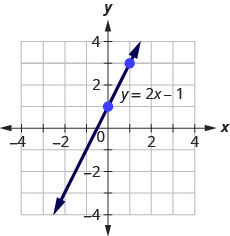
To find the slope of the line, we need to choose two points on the line. We’ll use the points [latex](0,1)[/latex] and [latex](1,3)[/latex].
Step 1: Find the rise and run.
[latex]\begin{align*}m&=\frac{rise}{run}\\m&=\frac21\\m&=2\end{align*}[/latex]
Step 2: Find the [latex]y[/latex]-intercept of the line.
The [latex]y[/latex]-intercept is the point [latex](0, 1)[/latex].
Step 3: We found the slope [latex]m=2[/latex] and the y-intercept [latex](0,1)[/latex].
[latex]\begin{eqnarray*}y&=&{\color{red}{2}}x\;+\;{\color{blue}{1}}\\y&=&{\color{red}{m}}x\;+\;{\color{blue}{b}}\end{eqnarray*}[/latex]
The slope is the same as the coefficient of [latex]x[/latex] and the [latex]y[/latex]-coordinate of the [latex]y[/latex]-intercept is the same as the constant term.
Try It
Identify the Slope and [latex]y[/latex]-Intercept From an Equation of a Line
In Understand Slope of a Line, we graphed a line using the slope and a point. When we are given an equation in slope–intercept form, we can use the [latex]y[/latex]-intercept as the point, and then count out the slope from there. Let’s practice finding the values of the slope and [latex]y[/latex]-intercept from the equation of a line.
Example 13
Identify the slope and [latex]y[/latex]-intercept of the line with equation [latex]y=-3x+5[/latex].
Solution
We compare our equation to the slope–intercept form of the equation.
[latex]{y\;=\;}{\color{red}{m}}{x\;+\;}{\color{blue}{b}}[/latex]
Step 1: Write the equation of the line.
[latex]{y=}{\color{red}{-}}{{\color{red}{3}}x\;+\;}{\color{blue}{5}}[/latex]
Step 2: Identify the slope.
[latex]{m=}{\color{red}{-}}{}{\color{red}{3}}[/latex]
Step 3: Identify the [latex]y[/latex]-intercept.
[latex]y[/latex]-intercept is [latex]{\color{black}{(}}{{\color{black}{0}}{\color{black}{,}}{\color{black}{\;}}{\color{blue}{5}}}{\color{black}{)}}[/latex].
Try It
31) Identify the slope and [latex]y[/latex]-intercept of the line [latex]y=\frac{2}{5}x-1[/latex]
Solution
[latex]\frac{2}{5}[/latex]; [latex](0,-1)[/latex]
32) Identify the slope and [latex]y[/latex]-intercept of the line [latex]y=-\frac{4}{3}x+1[/latex]
Solution
[latex]-\frac{4}{3}[/latex]; [latex](0,1)[/latex]
When an equation of a line is not given in slope–intercept form, our first step will be to solve the equation for [latex]y[/latex].
Example 14
Solution
This equation is not in slope-intercept form. To compare it to the slope-intercept form we must first solve the equation for [latex]y[/latex].
Step 1: Solve for [latex]y[/latex].
[latex]x+2y=6[/latex]
Step 2: Subtract [latex]x[/latex] from each side.
[latex]2y\;=\;-x\;+\;6[/latex]
Step 3: Divide both sides by [latex]2[/latex].
[latex]\begin{align*} &\;&\frac{2y}{2}&=\frac{-x+6}2\\[2ex] &\text{Simplify.}&\frac{2y}2&=\frac{-x}2+\frac62 \end{align*}[/latex]
Remember: [latex]\frac{a+b}{c}=\frac{a}{c}+\frac{b}{c}[/latex]
[latex]y\;=-\frac12x\;+\;3[/latex]
Step 6: Write the slope-intercept form of the equation of the line.
[latex]{y\;=\;}{\color{red}{m}}{x\;+\;}{\color{blue}{b}}{}[/latex]
Step 7: Write the equation of the line.
[latex]{y\;=\;-}{\color{red}{\frac12}}{x\;+\;}{\color{blue}{3}}[/latex]
Step 8: Identify the slope.
[latex]{\color{black}{m}}{{\color{black}{\;}}{\color{black}{=}}{\color{blue}{\;}}{\color{red}{-}}}{\color{red}{\frac12}}[/latex]
Step 9: Identify the [latex]y[/latex]-intercept.
[latex]y[/latex]-intercept = [latex]{(0,\;}{\color{blue}{3}}{)}[/latex]
Try It
33) Identify the slope and [latex]y[/latex]-intercept of the line [latex]x+4y=8[/latex].
Solution
[latex]-\frac{1}{4}[/latex]; [latex](0,2)[/latex]
34) Identify the slope and [latex]y[/latex]-intercept of the line [latex]3x+2y=12[/latex].
Solution
[latex]-\frac{3}{2}[/latex]; [latex](0,6)[/latex]
Graph a Line Using its Slope and Intercept
Now that we know how to find the slope and [latex]y[/latex]-intercept of a line from its equation, we can graph the line by plotting the [latex]y[/latex]-intercept and then using the slope to find another point.
How to
Graph a line using its slope and [latex]y[/latex]-intercept.
- Find the slope-intercept form of the equation of the line.
- Identify the slope and [latex]y[/latex]-intercept.
- Plot the [latex]y[/latex]-intercept.
- Use the slope formula [latex]m=\frac{rise}{run}[/latex] to identify the rise and the run.
- Starting at the [latex]y[/latex]-intercept, count out the rise and run to mark the second point.
- Connect the points with a line.
Example 15
Graph the line of the equation [latex]y=4x-2[/latex] using its slope and [latex]y[/latex]-intercept.
Solution
Step 1: Find the slope-intercept form of the equation.
This equation is in slope-intercept form
[latex]y=4x-2[/latex]
Step 2: Identify the slope and [latex]y[/latex]-intercept.
Use [latex]{y=}{\color{red}{m}}{x+}{\color{blue}{b}}[/latex]
Find the slope.
Find the [latex]y[/latex]-intercept.
[latex]\begin{align*}y&={\color{red}{m}}x+{\color{blue}{b}}\\y&={\color{red}{4}}x+({\color{blue}{-2}})\\m&=4\\b&=-2, (0,-2) \end{align*}[/latex]
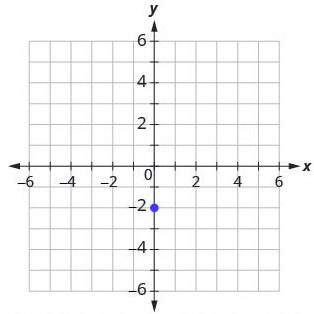
Step 4: Use the slope formula [latex]m=\frac{rise}{run}[/latex] to identify the rise and the run.
Identify the rise and the run.
[latex]\begin{align*} m&=4\\ \frac{rise}{run}&=\frac41\\ rise&=4\\ run&=1 \end{align*}[/latex]
Step 5: Starting at the y-intercept, count out the rise and run to mark the second point.
Start at (0,-2) and count the rise and run.
Up 4, right 1.
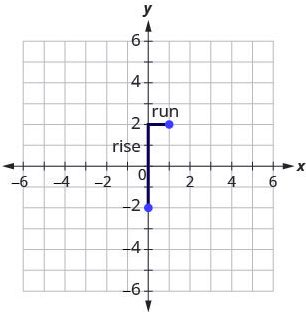
Step 6: Connect the points with a line.
Connect the two points with a line.
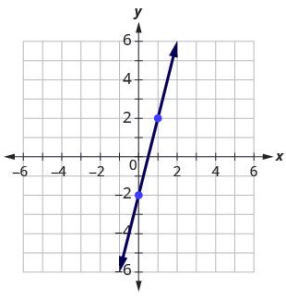
Example 16
Graph the line of the equation [latex]y=−x+4[/latex] using its slope and [latex]y[/latex]-intercept.
Solution
[latex]y=mx+b[/latex]
Step 1: The equation is in slope–intercept form.
[latex]y=−x+4[/latex]
Step 2: Identify the slope and [latex]y[/latex]-intercept.
[latex]m=-1[/latex]
[latex]y[/latex]-intercept is [latex](0, 4)[/latex]
Step 3: Plot the [latex]y[/latex]-intercept.
See graph below.
Step 4: Identify the rise and the run.
[latex]m=\frac{-1}{1}[/latex]
Step 5: Count out the rise and run to mark the second point.
[latex]rise =−1[/latex], [latex]run=1[/latex]
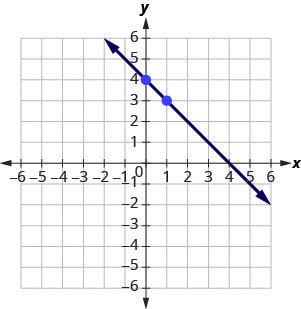
Step 6: Draw the line.
Step 7: To check your work, you can find another point on the line and make sure it is a solution to the equation.
In the graph, we see the line goes through [latex](4, 0)[/latex].
Step 8: Check.
[latex]\begin{align*}y&=-x+4\\0&\overset?=-4+4\\0&=0\checkmark\end{align*}[/latex]
Example 17
Graph the line of the equation [latex]y=-\frac{2}{3}x-3[/latex] using its slope and [latex]y[/latex]-intercept.
Solution
[latex]y=mx+b[/latex]
Step 1: The equation is in slope-intercept form.
[latex]m=-\frac{2}{3}[/latex]; [latex]y[/latex]-intercept is [latex](0, −3)[/latex]
Step 2: Identify the slope and [latex]y[/latex]-intercept.
See graph below.
Step 3: Plot the [latex]y[/latex]-intercept.
Step 4: Identify the rise and the run.
Step 5: Count out the rise and run to mark the second point.
Step 6: Draw the line.
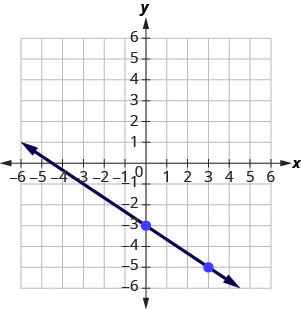
Example 18
Graph the line of the equation [latex]4x-3y=12[/latex] using its slope and [latex]y[/latex]-intercept.
Solution
[latex]4x-3y=12[/latex]
Step 1: Find the slope-intercept form of the equation.
[latex]\begin{align*} 4x-3y&=12\\ -3y&=-4x+12\\ -\frac{3y}{3}&=\frac{-4x+12}{-3} \end{align*}[/latex]
Step 2: The equation is now in slope-intercept form.
[latex]y=\frac{4}{3}x-4[/latex]
Step 3: Identify the slope and [latex]y[/latex]-intercept.
[latex]m=\frac{4}{3}[/latex]
[latex]y[/latex]-intercept is [latex](0, −4)[/latex]
See graph below.
Step 4: Plot the [latex]y[/latex]-intercept.
Step 5: Identify the rise and the run; count out the rise and run to mark the second point.
Step 6: Draw the line.
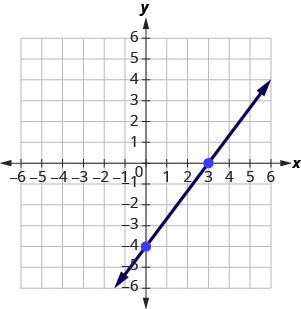
Try It
We have used a grid with [latex]x[/latex] and [latex]y[/latex] both going from about [latex]-10[/latex] to [latex]10[/latex] for all the equations we’ve graphed so far. Not all linear equations can be graphed on this small grid. Often, especially in applications with real-world data, we’ll need to extend the axes to bigger positive or smaller negative numbers.
Example 19
Graph the line of the equation [latex]y=0.2x+45[/latex] using its slope and [latex]y[/latex]-intercept.
Solution
We’ll use a grid with the axes going from about [latex]-80[/latex] to [latex]80[/latex].
[latex]y=mx+b[/latex]
Step 1: The equation is in slope-intercept form.
[latex]y=0.2x+45[/latex]
Step 2: Identify the slope and [latex]y[/latex]-intercept.
[latex]m = 0.2[/latex]
The [latex]y[/latex]-intercept is [latex](0, 45)[/latex].
Step 3: Plot the [latex]y[/latex]-intercept.
See graph below.
Step 4: Count out the rise and run to mark the second point.
The slope is [latex]m = 0.2[/latex]; in fraction form this means [latex]m=\frac{2}{10}[/latex]. Given the scale of our graph, it would be easier to use the equivalent fraction [latex]m=\frac{10}{50}[/latex].
Step 5: Draw the line.
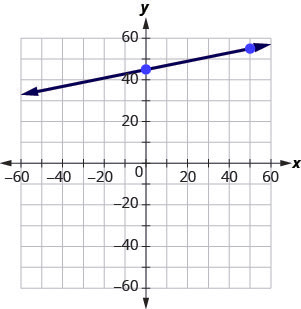
Choose the Most Convenient Method to Graph a Line
Now that we have seen several methods we can use to graph lines, how do we know which method to use for a given equation?
While we could plot points, use the slope-intercept form, or find the intercepts for any equation, if we recognize the most convenient way to graph a certain type of equation, our work will be easier. Generally, plotting points is not the most efficient way to graph a line. We saw better methods in previous sections and earlier in this section. Let’s look for some patterns to help determine the most convenient method to graph a line.
Here are six equations we graphed in this chapter, and the method we used to graph each of them.
| Equation | Method | |
|---|---|---|
| #1 |
[latex]x = 2[/latex] |
Vertical Line |
| #2 | [latex]y = 4[/latex] | Horizontal Line |
| #3 | [latex]-x+2y =6[/latex] | Intercepts |
| #4 | [latex]4x-3y =12[/latex] | Intercepts |
| #5 | [latex]y=4x-2[/latex] | Slope-intercept |
| #6 | [latex]y=-x+4[/latex] | Slope-intercept |
Equations #1 and #2 each have just one variable. Remember, in equations of this form the value of that one variable is constant; it does not depend on the value of the other variable. Equations of this form have graphs that are vertical or horizontal lines.
In equations #3 and #4, both [latex]x[/latex] and [latex]y[/latex] are on the same side of the equation. These two equations are of the form [latex]Ax\;+\;By\;=\;C[/latex]. We substituted [latex]y=0[/latex] to find the [latex]x[/latex]-intercept and [latex]x=0[/latex] to find the [latex]y[/latex]-intercept, and then found a third point by choosing another value for [latex]x[/latex] or [latex]y[/latex].
Equations #5 and #6 are written in slope-intercept form. After identifying the slope and [latex]y[/latex]-intercept from the equation we used them to graph the line.
This leads to the following strategy.
How to
Strategy for Choosing the Most Convenient Method to Graph a Line
Consider the form of the equation.
- If it only has one variable, it is a vertical or horizontal line.
- [latex]x=a[/latex] is a vertical line passing through the [latex]x[/latex]-axis at [latex]a[/latex].
- [latex]y=b[/latex] is a horizontal line passing through the [latex]y[/latex]-axis at [latex]b[/latex].
- If [latex]y[/latex] is isolated on one side of the equation, in the form [latex]y=mx+b[/latex], graph by using the slope and [latex]y[/latex]-intercept.
- Identify the slope and [latex]y[/latex]-intercept and then graph.
- If the equation is of the form [latex]Ax\;+\;By\;=\;C[/latex], find the intercepts.
- Find the [latex]x[/latex]- and [latex]y[/latex]-intercepts, a third point, and then graph.
Example 20
Determine the most convenient method to graph each line.
a. [latex]y=-6[/latex]
b. [latex]5x-3y=15[/latex]
c. [latex]x=7[/latex]
d. [latex]y=\frac{2}{5}x-1[/latex]
Solution
a. [latex]y=-6[/latex]
This equation has only one variable, [latex]y[/latex]. Its graph is a horizontal line crossing the [latex]y[/latex]-axis at [latex]-6[/latex].
b. [latex]5x-3y=15[/latex]
This equation is of the form [latex]Ax\;+\;By\;=\;C[/latex]. The easiest way to graph it will be to find the intercepts and one more point.
c. [latex]x=7[/latex]
There is only one variable, [latex]x[/latex]. The graph is a vertical line crossing the [latex]x[/latex]-axis at [latex]7[/latex].
d. [latex]y=\frac{2}{5}x-1[/latex]
Since this equation is in [latex]y=mx+b[/latex] form, it will be easiest to graph this line by using the slope and [latex]y[/latex]-intercept.
Try It
45) Determine the most convenient method to graph each line:
a. [latex]3x+2y=12[/latex]
b. [latex]y=4[/latex]
c. [latex]y=\frac{1}{5}x-4[/latex]
d. [latex]x=-7[/latex]
Solution
a. intercepts
b. horizontal line
c. slope–intercept
d. vertical line
46) Determine the most convenient method to graph each line:
a. [latex]x=6[/latex]
b. [latex]y=-\frac{3}{4}x+1[/latex]
c. [latex]y=-8[/latex]
d. [latex]4x-3y=-1[/latex]
Solution
a. vertical line
b. slope–intercept
c. horizontal line
d. intercepts
Graph and Interpret Applications of Slope–Intercept
Many real-world applications are modeled by linear equations. We will take a look at a few applications here so you can see how equations written in slope–intercept form relate to real-world situations.
Usually, when a linear equation models a real-world situation, different letters are used for the variables, instead of [latex]x[/latex] and [latex]y[/latex]. The variable names remind us of what quantities are being measured.
Example 21
The equation [latex]F=\frac{9}{5}C+32[/latex] is used to convert temperatures, [latex]C[/latex], on the Celsius scale to temperatures, [latex]F[/latex], on the Fahrenheit scale.
a. Find the Fahrenheit temperature for a Celsius temperature of [latex]0[/latex].
b. Find the Fahrenheit temperature for a Celsius temperature of [latex]20[/latex].
c. Interpret the slope and [latex]F[/latex]-intercept of the equation.
d. Graph the equation.
Solution
a.
Step 1: Find the Fahrenheit temperature for a Celsius temperature of [latex]0[/latex].
Step 2: Find [latex]F[/latex] when [latex]C=0[/latex].
[latex]\begin{align*}F&=\frac9 5 C+32\\F&=\frac9 5\times 0+32\\F&= 32\end{align*}[/latex]
b.
Step 1: Find the Fahrenheit temperature for a Celsius temperature of [latex]20[/latex].
Step 2: Find [latex]F[/latex] when [latex]C=20[/latex].
[latex]\begin{align*}F&=\frac9 5 C+32\\F&=\frac9 5 (20)+32\\F&= 36+32\\F&=68\end{align*}[/latex]
c.
Interpret the slope and [latex]F[/latex]-intercept of the equation. Even though this equation uses [latex]F[/latex] and [latex]C[/latex], it is still in slope–intercept form.
[latex]\begin{align*}{\color{red}{y}}&=m{\color{blue}{x}}+b\\{\color{red}{F}}&=m{\color{blue}{C}}+b\\F&=\frac95C+32\end{align*}[/latex]
The slope, [latex]\frac{9}{5}[/latex], means that the temperature Fahrenheit ([latex]F[/latex]) increases [latex]9[/latex] degrees when the temperature Celsius [latex](C)[/latex] increases [latex]5[/latex] degrees. The [latex]F[/latex]-intercept means that when the temperature is [latex](0)[/latex] on the Celsius scale, it is [latex]32^\circ[/latex] on the Fahrenheit scale.
d.
Graph the equation. We’ll need to use a larger scale than our usual. Start at the [latex]F[/latex]-intercept [latex](0,32)[/latex] then count out the rise of [latex]9[/latex] and the run of [latex]5[/latex] to get a second point. See Figure 3.10.62
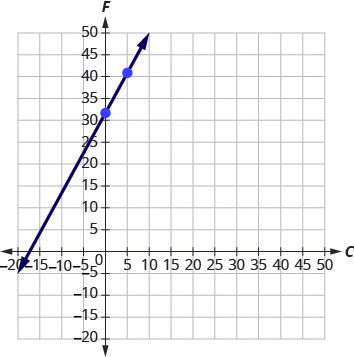
Try It
47) The equation [latex]h=2s+50[/latex] is used to estimate a woman’s height in inches, [latex]h[/latex], based on her shoe size, [latex]s[/latex].
a. Estimate the height of a child who wears woman’s shoe size [latex]0[/latex].
b. Estimate the height of a woman with shoe size [latex]8[/latex].
c. Interpret the slope and [latex]h[/latex]-intercept of the equation.
d. Graph the equation.
Solution
a. [latex]50[/latex] inches
b. [latex]66[/latex] inches
c. The slope, [latex]2[/latex], means that the height, [latex]h[/latex], increases by [latex]2[/latex] inches when the shoe size, [latex]s[/latex], increases by [latex]1[/latex]. The [latex]h[/latex]-intercept means that when the shoe size is [latex]0[/latex], the height is [latex]50[/latex] inches.
d.
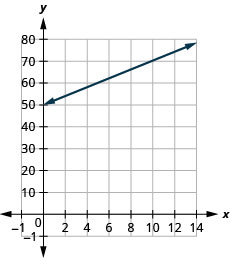
48) The equation [latex]T=\frac{1}{4}n+40[/latex] is used to estimate the temperature in degrees Fahrenheit, [latex]T[/latex], based on the number of cricket chirps, [latex]n[/latex], in one minute.
a. Estimate the temperature when there are no chirps.
b. Estimate the temperature when the number of chirps in one minute is [latex]100[/latex].
c. Interpret the slope and [latex]T[/latex]-intercept of the equation.
d. Graph the equation.
Solution
a. [latex]40[/latex] degrees
b. [latex]65[/latex] degrees
c. The slope, [latex]\frac{1}{4}[/latex], means that the temperature Fahrenheit ([latex]F[/latex]) increases [latex]1[/latex] degree when the number of chirps, [latex]n[/latex], increases by [latex]4[/latex]. The [latex]T[/latex]-intercept means that when the number of chirps is [latex]0[/latex], the temperature is [latex]40^\circ[/latex]
d.
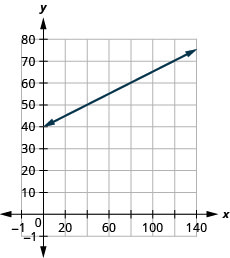
The cost of running some types of business has two components—a fixed cost and a variable cost. The fixed cost is always the same regardless of how many units are produced. This is the cost of rent, insurance, equipment, advertising, and other items that must be paid regularly. The variable cost depends on the number of units produced. It is for the material and labour needed to produce each item.
Example 22
Stella has a home business selling gourmet pizzas. The equation [latex]C=4p+25[/latex] models the relation between her weekly cost, [latex]C[/latex], in dollars and the number of pizzas, [latex]p[/latex], that she sells.
a. Find Stella’s cost for a week when she sells no pizzas.
b. Find the cost for a week when she sells [latex]15[/latex] pizzas.
c. Interpret the slope and [latex]C[/latex]-intercept of the equation.
d. Graph the equation.
Solution
a.
Step 1: Find Stella's cost for a week when she sells no pizzas.
[latex]C=4p+25[/latex]
Step 2: Find [latex]C[/latex] when [latex]p=0[/latex].
[latex]\begin{align*} &\;&C&=4p+25\\ &\;&C&=4(0)+25\\ &\text{Simplify.}&C&=25 \end{align*}[/latex]
Stella's fixed cost is [latex]\$25[/latex] when she sells no pizzas.
b.
Step 1: Find the cost for a week when she sells 15 pizzas.
[latex]C=4p+25[/latex]
Step 2: Find [latex]C[/latex] when [latex]p=15[/latex].
[latex]\begin{align*} &\;&C&=4p+25\\ &\;&C&=4(15)+25\\ &\text{Simplify.}&C&=60+25\\ &\;&C&=85 \end{align*}[/latex]
Stella's costs are [latex]\$85[/latex] when she sells [latex]15[/latex] pizzas.
c.
Step 1: Interpret the slope and [latex]C[/latex]-intercept of the equation.
[latex]\begin{align*} {\color{red}{y}}&=m{\color{blue}{x}}+b\\ {\color{red}{C}}&=4{\color{blue}{p}}+25 \end{align*}[/latex]
The slope, [latex]4[/latex], means that the cost increases by [latex]\$4[/latex] for each pizza Stella sells. The [latex]C[/latex]-intercept means that even when Stella sells no pizzas, her costs for the week are [latex]\$25[/latex].
d.
Step 1: Graph the equation.
We'll need to use a larger scale than our usual. Start at the [latex]C[/latex]-intercept [latex](0, 25)[/latex] then count out the rise of [latex]4[/latex] and the run of [latex]1[/latex] to get a second point

Try It
49) Sam drives a delivery van. The equation [latex]C=0.5m+60[/latex] models the relation between his weekly cost, [latex]C[/latex], in dollars and the number of miles, [latex]m[/latex], that he drives.
a. Find Sam’s cost for a week when he drives [latex]0[/latex] miles.
b. Find the cost for a week when he drives [latex]250[/latex] miles.
c. Interpret the slope and [latex]C[/latex]-intercept of the equation.
d. Graph the equation.
Solution
a. [latex]\$60[/latex]
b. [latex]\$185[/latex]
c. The slope, [latex]0.5[/latex], means that the weekly cost, [latex]C[/latex], increases by [latex]\$0.50[/latex] when the number of miles driven, [latex]n[/latex], increases by [latex]1[/latex]. The [latex]C[/latex]-intercept means that when the number of miles driven is [latex]0[/latex], the weekly cost is [latex]\$60[/latex].
d.
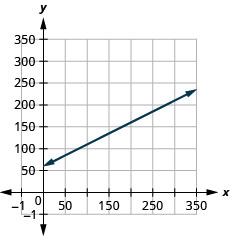
50) Loreen has a calligraphy business. The equation [latex]C=1.8n+35[/latex] models the relation between her weekly cost, [latex]C[/latex], in dollars and the number of wedding invitations, [latex]n[/latex], that she writes.
a. Find Loreen’s cost for a week when she writes no invitations.
b. Find the cost for a week when she writes [latex]75[/latex] invitations.
c. Interpret the slope and [latex]C[/latex]-intercept of the equation.
d. Graph the equation.
Solution
a. [latex]\$35[/latex]
b. [latex]\$170[/latex]
c. The slope, [latex]1.8[/latex], means that the weekly cost, [latex]C[/latex], increases by [latex]\$1.80[/latex] when the number of invitations, [latex]n[/latex], increases by [latex]1.80[/latex].
The [latex]C[/latex]-intercept means that when the number of invitations is [latex]0[/latex], the weekly cost is [latex]\$35[/latex].
d.
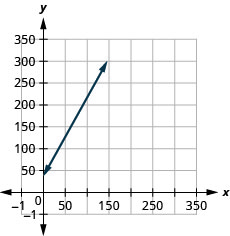
Use Slopes to Identify Parallel Lines
The slope of a line indicates how steep the line is and whether it rises or falls as we read it from left to right. Two lines that have the same slope are called parallel lines. Parallel lines never intersect.

We say this more formally in terms of the rectangular coordinate system. Two lines that have the same slope and different [latex]y[/latex]-intercepts are called parallel lines. See Figure 3.10.69.
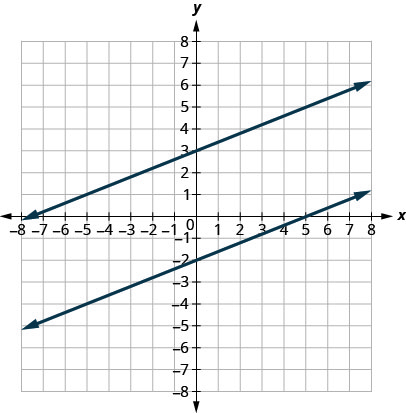
What about vertical lines? The slope of a vertical line is undefined, so vertical lines don’t fit in the definition above. We say that vertical lines that have different [latex]x[/latex]-intercepts are parallel. See Figure 3.10.70.
Vertical lines with different [latex]x[/latex]-intercepts are parallel.
Parallel Lines
Parallel lines are lines in the same plane that do not intersect.
- Parallel lines have the same slope and different [latex]y[/latex]-intercepts.
- If [latex]m_1[/latex] and [latex]m_2[/latex] are the slopes of two parallel lines then [latex]m_1=m_2[/latex].
- Parallel vertical lines have different [latex]x[/latex]-intercepts.
Let’s graph the equations [latex]y=-2x+3[/latex] and [latex]2x+y=-1[/latex] on the same grid. The first equation is already in slope-intercept form: [latex]y=-2x+3[/latex]. We solve the second equation for [latex]y[/latex]:
Graph the lines.
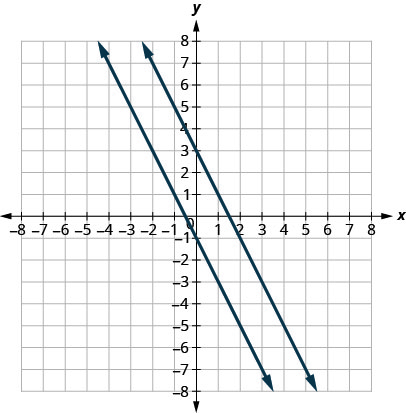
Notice the lines look parallel. What is the slope of each line? What is the [latex]y[/latex]-intercept of each line?
| [latex]y = mx+b[/latex] | [latex]y = mx+b[/latex] |
| [latex]y = -2x +3[/latex] | [latex]y = -2x-1[/latex] |
| [latex]m = -2[/latex] | [latex]m = -2[/latex] |
| [latex]b = 3, (0,3)[/latex] | [latex]b = -1, (0,-1)[/latex] |
The slopes of the lines are the same and the [latex]y[/latex]-intercept of each line is different. So we know these lines are parallel.
Since parallel lines have the same slope and different [latex]y[/latex]-intercepts, we can now just look at the slope-intercept form of the equations of lines and decide if the lines are parallel.
Example 23
Use slopes and [latex]y[/latex]-intercepts to determine if the lines [latex]3x-2y=6[/latex] and [latex]y=\frac{3}{2}x+1[/latex] are parallel.
Solution
Step 1: Solve the first equation for [latex]y[/latex].
| [latex]\begin{align*} 3x-2y&=6\\ -2y&=-3x+6\\ \frac{-2y}{-2}&=\frac{3x+6}{-2}\\y&=\frac{3}{2}x-3\end{align*}[/latex] | [latex]y=\frac32x+1[/latex] |
Step 2: The equation is now in slope-intercept form.
| [latex]y=\frac{3}{2}x-3[/latex] |
Step 3: The equation of the second line is already in slope-intercept form.
| [latex]y=\frac{3}{2}x+1[/latex] |
Step 4: Identify the slope and [latex]y[/latex]-intercept of both lines.
| [latex]\begin{align*}y&=mx+b\\m&=\frac{3}{2}\\y&= \frac{3}{2}x-3\end{align*}[/latex] | [latex]\begin{align*}y&=mx+b\\m&=\frac{3}{2}\\y=\frac{3}{2}x+1\\y&=\frac{3}{2}x+1\end{align*}[/latex] |
| [latex]y[/latex]-intercept is (0, −3) | [latex]y[/latex]-intercept is [latex](0, 1)[/latex] |
The lines have the same slope and different [latex]y[/latex]-intercepts and so they are parallel. You may want to graph the lines to confirm whether they are parallel.
Try It
51) Use slopes and [latex]y[/latex]-intercepts to determine if the lines [latex]2x+5y=5[/latex] and [latex]y=-\frac{2}{5}x-4[/latex] are parallel.
Solution
parallel
52) Use slopes and [latex]y[/latex]-intercepts to determine if the lines [latex]4x-3y=6[/latex] and [latex]y=\frac{4}{3}x-1[/latex]are parallel.
Solution
parallel
Example 24
Use slopes and [latex]y[/latex]-intercepts to determine if the lines [latex]y=-4[/latex] and [latex]y=3[/latex] are parallel.
Solution
| [latex]y=-4[/latex] | [latex]y=3[/latex] |
Step 1: Write each equation in slope-intercept form.
Since there is no [latex]x[/latex] term we write [latex]0x[/latex].
| [latex]y=0x-4[/latex] | [latex]y=0x+3[/latex] |
Step 2: Identify the slope and [latex]y[/latex]-intercept of both lines.
| [latex]m=0[/latex] | [latex]m=0[/latex] |
| [latex]y[/latex]-intercept is [latex](0, 4)[/latex] | [latex]y[/latex]-intercept is [latex](0, 3)[/latex] |
The lines have the same slope and different [latex]y[/latex]-intercepts so they are parallel.
There is another way you can look at this example. If you recognize right away from the equations that these are horizontal lines, you know their slopes are both [latex]0[/latex]. Since the horizontal lines cross the [latex]y[/latex]-axis at [latex]y=-4[/latex] and at [latex]y=3[/latex], we know the [latex]y[/latex]-intercepts are [latex](0,-4)[/latex] and [latex](0,3)[/latex]. The lines have the same slope and different [latex]y[/latex]-intercepts and so they are parallel.
Try It
53) Use slopes and [latex]y[/latex]-intercepts to determine if the lines [latex]y=8[/latex] and [latex]y=-6[/latex] are parallel.
Solution
parallel
54) Use slopes and [latex]y[/latex]-intercepts to determine if the lines [latex]y=1[/latex] and [latex]y=-5[/latex] are parallel.
Solution
parallel
Example 25
Use slopes and [latex]y[/latex]-intercepts to determine if the lines [latex]x=-2[/latex] and [latex]x=-5[/latex] are parallel.
Solution
Since there is no [latex]y[/latex], the equations cannot be put in slope-intercept form. But we recognize them as equations of vertical lines. Their [latex]x[/latex]-intercepts are [latex]-2[/latex] and [latex]-5[/latex]. Since their [latex]x[/latex]-intercepts are different, the vertical lines are parallel.
Try It
55) Use slopes and [latex]y[/latex]-intercepts to determine if the lines [latex]x=1[/latex] and [latex]x=-5[/latex] are parallel.
Solution
parallel
56) Use slopes and [latex]y[/latex]-intercepts to determine if the lines [latex]x=8[/latex] and [latex]x=-6[/latex] are parallel.
Solution
parallel
Example 26
Use slopes and [latex]y[/latex]-intercepts to determine if the lines [latex]y=2x-3[/latex] and [latex]-6x+3y=-9[/latex] are parallel. You may want to graph these lines, too, to see what they look like.
Solution
| [latex]y=2x-3[/latex] | [latex]-6x+3y=-9[/latex] |
Step 1: The first equation is already in slope-intercept form.
| [latex]y=2x-3[/latex] |
Step 2: Solve the second equation for [latex]y[/latex].
| [latex]\begin{align*} -6x+3y&=-9\\ 3y&=6x-9\\ \frac{3y}{3}&=\frac{6x-9}{3}\\ y&=2x-3 \end{align*}[/latex] |
Step 3: The second equation is now in slope-intercept form.
| [latex]y=2x-3[/latex] | [latex]y=2x-3[/latex] |
Step 4: Identify the slope and [latex]y[/latex]-intercept of both lines.
| [latex]\begin{align*} y&=2x-3\\ y&=mx+b\\ m&=2 \end{align*}[/latex] | [latex]\begin{align*} y&=2x-3\\ y&=mx+b\\ m&=2 \end{align*}[/latex] |
| [latex]y[/latex]-intercept is [latex](0, −3)[/latex] | [latex]y[/latex]-intercept is [latex](0, −3)[/latex] |
The lines have the same slope, but they also have the same [latex]y[/latex]-intercepts. Their equations represent the same line. They are not parallel; they are the same line.
Try It
57) Use slopes and [latex]y[/latex]-intercepts to determine if the lines [latex]y=-\frac{1}{2}x+1[/latex] and [latex]x+2y=2[/latex] are parallel.
Solution
not parallel; same line
58) Use slopes and [latex]y[/latex]-intercepts to determine if the lines [latex]y=\frac{3}{4}x-3[/latex] and [latex]3x-4y=12[/latex] are parallel.
Solution
not parallel; same line
Use Slopes to Identify Perpendicular Lines
Let’s look at the lines whose equations are [latex]y=\frac{1}{4}x-1[/latex] and [latex]y=-4x+2[/latex], shown in Figure 3.10.72.
These lines lie in the same plane and intersect at right angles. We call these lines perpendicular.
What do you notice about the slopes of these two lines? As we read from left to right, the line [latex]y=\frac{1}{4}x-1[/latex] rises, so its slope is positive. The line [latex]y=-4x+2[/latex] drops from left to right, so it has a negative slope. Does it make sense to you that the slopes of two perpendicular lines will have opposite signs?
If we look at the slope of the first line, [latex]m_1=\frac{1}{4}[/latex] , and the slope of the second line, [latex]m_2=-4[/latex], we can see that they are negative reciprocals of each other. If we multiply them, their product is [latex]-1[/latex].
This is always true for perpendicular lines and leads us to this definition.
Perpendicular Lines
Perpendicular lines are lines in the same plane that form a right angle.
If [latex]m_1[/latex] and [latex]m_2[/latex] are the slopes of two perpendicular lines, then:
Vertical lines and horizontal lines are always perpendicular to each other.
We were able to look at the slope-intercept form of linear equations and determine whether or not the lines were parallel. We can do the same thing for perpendicular lines.
We find the slope-intercept form of the equation and then see if the slopes are negative reciprocals. If the product of the slopes is [latex]-1[/latex], the lines are perpendicular. Perpendicular lines may have the same [latex]y[/latex]-intercepts.
Example 27
Use slopes to determine if the lines, [latex]y=-5x-4[/latex] and [latex]x-5y=5[/latex] are perpendicular.
Solution
Step 1: The first equation is already in slope-intercept form.
| [latex]y=-5x-4[/latex] |
Step 2: Solve the second equation for [latex]y[/latex].
| [latex]\begin{align*} x-5y&=5\\ -5y&=x+5\\ \frac{-5y}{-5}&=\frac{x+5}{-5}\\ y&=\frac{1}{-5}x-1 \end{align*}[/latex] |
Step 3: Identify the slope of each line.
| [latex]\begin{align*} y&=-5x-4\\ y&=mx+b\\ m_1&=-5 \end{align*}[/latex] | [latex]\begin{align*} y&=\frac{1}{5}x-4\\ y&=mx+b\\ m_2&=\frac{1}{5} \end{align*}[/latex] |
The slopes are negative reciprocals of each other, so the lines are perpendicular. We check by multiplying the slopes,
Try It
59) Use slopes to determine if the lines [latex]y=-3x+2[/latex] and [latex]x-3y=4[/latex] are perpendicular.
Solution
perpendicular
60) Use slopes to determine if the lines [latex]y=2x-5[/latex] and [latex]x+2y=-6[/latex] are perpendicular.
Solution
perpendicular
Example 28
Use slopes to determine if the lines, [latex]7x+2y=3[/latex] and [latex]2x+7y=5[/latex] are perpendicular.
Solution
Step 1: Solve the equations for [latex]y[/latex].
| [latex]\begin{align*} 7x+2y&=3\\ 2y&=-7x+3\\ \frac{2y}{2}&=\frac{-7x+3}{2}\\ y&=\frac{-7}{2}x+\frac{3}{2} \end{align*}[/latex] | [latex]\begin{align*} 2x+7y&=5\\ 2y&=-2x+5\\ \frac{7y}{7}&=\frac{-2x+5}{7}\\ y&=\frac{-2}{7}x+\frac{5}{7} \end{align*}[/latex] |
Step 2: Identify the slope of each line.
| [latex]\begin{align*}y&=mx+b\\m_1&=-\frac{7}{2}\end{align*}[/latex] | [latex]\begin{align*}y&=mx+b\\m_2&=-\frac{2}{7}\end{align*}[/latex] |
The slopes are reciprocals of each other, but they have the same sign. Since they are not negative reciprocals, the lines are not perpendicular.
Try It
61) Use slopes to determine if the lines [latex]5x+4y=1[/latex] and [latex]4x+5y=3[/latex] are perpendicular.
Solution
not perpendicular
62) Use slopes to determine if the lines [latex]2x-9y=3[/latex] and [latex]9x-2y=1[/latex] are perpendicular.
Solution
not perpendicular
Key Concepts
- Find the Slope of a Line from its Graph using [latex]m=\frac{rise}{run}[/latex]
- Locate two points on the line whose coordinates are integers.
- Starting with the point on the left, sketch a right triangle, going from the first point to the second point.
- Count the rise and the run on the legs of the triangle.
- Take the ratio of rise to run to find the slope.
- Graph a Line Given a Point and the Slope
- Plot the given point.
- Use the slope formula [latex]m=\frac{rise}{run}[/latex] to identify the rise and the run.
- Starting at the given point, count out the rise and run to mark the second point.
- Connect the points with a line.
- Slope of a Horizontal Line
- The slope of a horizontal line, [latex]y=b[/latex], is [latex]0[/latex].
- Slope of a vertical line
- The slope of a vertical line, [latex]x=a[/latex], is undefined
Graph a Line Using its Slope and y-Intercept
- The slope-intercept form of an equation of a line with slope [latex]m[/latex] and [latex]y[/latex]-intercept, [latex](0,b)[/latex] is, [latex]y=mx+b[/latex].
- Find the slope-intercept form of the equation of the line.
- Identify the slope and [latex]y[/latex]-intercept.
- Plot the [latex]y[/latex]-intercept.
- Use the slope formula [latex]m=\frac{rise}{run}[/latex] to identify the rise and the run.
- Starting at the [latex]y[/latex]-intercept, count out the rise and run to mark the second point.
- Connect the points with a line.
- Strategy for Choosing the Most Convenient Method to Graph a Line: Consider the form of the equation.
- If it only has one variable, it is a vertical or horizontal line.
[latex]x=a[/latex] is a vertical line passing through the [latex]x[/latex]-axis at [latex]a[/latex].
[latex]y=b[/latex] is a horizontal line passing through the [latex]y[/latex]-axis at [latex]b[/latex]. - If [latex]y[/latex] is isolated on one side of the equation, in the form [latex]y=mx+b[/latex], graph by using the slope and [latex]y[/latex]-intercept.
Identify the slope and [latex]y[/latex]-intercept and then graph. - If the equation is of the form [latex]Ax\;+\;By\;=\;C[/latex], find the intercepts.
Find the [latex]x[/latex]-intercept and [latex]y[/latex]-intercept, a third point, and then graph.
- If it only has one variable, it is a vertical or horizontal line.
- Parallel lines are lines in the same plane that do not intersect.
- Parallel lines have the same slope and different [latex]y[/latex]-intercepts.
- If [latex]m_1[/latex] and [latex]m_2[/latex] are the slopes of two parallel lines then [latex]m_1=m_2[/latex].
- Parallel vertical lines have different [latex]x[/latex]-intercepts.
- Parallel lines have the same slope and different [latex]y[/latex]-intercepts.
- Perpendicular lines are lines in the same plane that form a right angle.
- If [latex]m_1[/latex] and [latex]m_2[/latex] are the slopes of two perpendicular lines, then [latex]m_1\cdot m_2=-1[/latex] and [latex]m_1=-\frac{1}{m_2}[/latex]
- Vertical lines and horizontal lines are always perpendicular to each other.
Glossary
- geoboard
- A geoboard is a board with a grid of pegs on it.
- negative slope
- A negative slope of a line goes down as you read from left to right.
- positive slope
- A positive slope of a line goes up as you read from left to right.
- rise
- The rise of a line is its vertical change.
- run
- The run of a line is its horizontal change.
- slope formula
- The slope of the line between two points [latex](x_1,y_1)[/latex] and [latex](x_2,y_2)[/latex] is [latex]m=\frac{y_2-y_1}{x_2-x_1}[/latex]
- slope of a line
- The slope of a line is [latex]m=\frac{rise}{run}[/latex]. The rise measures the vertical change and the run measures the horizontal change.
- parallel lines
- Lines in the same plane that do not intersect.
- perpendicular lines
- Lines in the same plane that form a right angle.
- slope-intercept form of an equation of a line
- The slope–intercept form of an equation of a line with slope [latex]m[/latex] and [latex]y[/latex]-intercept, [latex](0,b)[/latex] is, [latex]y=mx+b[/latex].
Instructions: For questions 1-16, find the slope of each line shown.
Exercises: Find the Slope of Horizontal and Vertical Lines
Instructions: For questions 17-24, find the slope of each line.
Solution
[latex]0[/latex]
Solution
undefined
Solution
[latex]0[/latex]
Solution
undefined
Exercises: Use the Slope Formula to find the Slope of a Line between Two Points
Instructions: For questions 25-36, use the slope formula to find the slope of the line between each pair of points.
Solution
[latex]\frac{5}{2}[/latex]
Solution
[latex]\frac{3}{4}[/latex]
Solution
[latex]-\frac{5}{2}[/latex]
Solution
[latex]-\frac{8}{7}[/latex]
Solution
[latex]\frac{7}{3}[/latex]
Solution
[latex]-1[/latex]
Exercises: Graph a Line Given a Point and the Slope
Instructions: For questions 37-52, graph each line with the given point and slope.
50. [latex]\left(-4,2\right)[/latex]; [latex]m=4[/latex]
52. [latex]\left(2,3\right)[/latex]; [latex]m=-1[/latex]
Exercises: Recognize the Relation Between the Graph and the Slope–Intercept Form of an Equation of a Line
Instructions: For questions 53-58, use the graph to find the slope and y-intercept of each line. Compare the values to the equation [latex]y=mx+b[/latex].
Solution
slope [latex]m=4[/latex] and [latex]y[/latex]-intercept [latex]\left(0,-2\right)[/latex]
Solution
slope [latex]m=-3[/latex] and [latex]y[/latex]-intercept [latex]\left(0,1\right)[/latex]
Solution
slope [latex]m=-\frac{2}{5}[/latex] and [latex]y[/latex]-intercept [latex]\left(0,3\right)[/latex]
Exercises: Identify the Slope and [latex]{\color{White}{y}}[/latex]-Intercept From an Equation of a Line
Instructions: For questions 59-68, identify the slope and [latex]y[/latex]-intercept of each line.
Solution
[latex]-9;(0,7)[/latex]
Solution
[latex]4;(0,-10)[/latex]
Solution
[latex]-4;(0,8)[/latex]
Solution
[latex]-\frac{8}{3};(0,4)[/latex]
Solution
[latex]\frac{7}{3};(0,-3)[/latex]
Exercises: Graph a Line Using Its Slope and Intercept
Instructions: For questions 69-84, graph the line of each equation using its slope and y-intercept.
78. [latex]y=-\frac{3}{4}x-1[/latex]
Exercises: Choose the Most Convenient Method to Graph a Line
Instructions: For questions 85-100, determine the most convenient method to graph each line.
Solution
horizontal line
Solution
vertical line
Solution
slope–intercept
Solution
intercepts
Solution
slope–intercept
Solution
horizontal line
Solution
intercepts
Solution
slope–intercept
Exercises: Graph and Interpret Applications of Slope–Intercept
Instructions: For questions 101-108, graph and interpret each application of slope-intercept.
101. The equation [latex]P=28+2.54w[/latex] models the relation between the amount of Randy’s monthly water bill payment, [latex]P[/latex], in dollars, and the number of units of water, [latex]w[/latex], used.
a. Find the payment for a month when Randy used [latex]0[/latex] units of water.
b. Find the payment for a month when Randy used [latex]15[/latex] units of water.
c. Interpret the slope and [latex]P[/latex]-intercept of the equation.
d. Graph the equation.
Solution
a. [latex]$28[/latex]
b. [latex]$66.10[/latex]
c. The slope, [latex]2.54[/latex], means that Randy’s payment, [latex]P[/latex], increases by [latex]$2.54[/latex] when the number of units of water he used, [latex]w[/latex], increases by [latex]1[/latex]. The [latex]P[/latex]–intercept means that if the number units of water Randy used was [latex]0[/latex], the payment would be [latex]$28[/latex].
d.

102. The equation [latex]P=31+1.75w[/latex] models the relation between the amount of Tuyet’s monthly water bill payment, [latex]P[/latex], in dollars, and the number of units of water, [latex]w[/latex], used.
a. Find Tuyet’s payment for a month when [latex]0[/latex] units of water are used.
b. Find Tuyet’s payment for a month when [latex]12[/latex] units of water are used.
c. Interpret the slope and [latex]P[/latex]-intercept of the equation.
d. Graph the equation.
103. Janelle is planning to rent a car while on vacation. The equation [latex]C=0.32m+15[/latex] models the relation between the cost in dollars, [latex]C[/latex], per day and the number of miles, [latex]m[/latex], she drives in one day.
a. Find the cost if Janelle drives the car [latex]0[/latex] miles one day.
b. Find the cost on a day when Janelle drives the car [latex]400[/latex] miles.
c. Interpret the slope and [latex]C[/latex]–intercept of the equation.
d. Graph the equation.
Solution
a. [latex]$15[/latex]
b. [latex]$143[/latex]
c. The slope, [latex]0.32[/latex], means that the cost, [latex]C[/latex], increases by [latex]$0.32[/latex] when the number of miles driven, [latex]m[/latex], increases by [latex]1[/latex]. The [latex]C[/latex]-intercept means that if Janelle drives [latex]0[/latex]miles one day, the cost would be [latex]$15[/latex].
d.
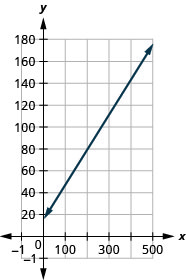
104. Bruce drives his car for his job. The equation [latex]R=0.575m+42[/latex] models the relation between the amount in dollars, [latex]R[/latex], that he is reimbursed and the number of miles, [latex]m[/latex], he drives in one day.
a. Find the amount Bruce is reimbursed on a day when he drives [latex]0[/latex] miles.
b. Find the amount Bruce is reimbursed on a day when he drives [latex]220[/latex] miles.
c. Interpret the slope and [latex]R[/latex]-intercept of the equation.
d. Graph the equation.
105. Patel’s weekly salary includes a base pay plus commission on his sales. The equation [latex]S=750+0.09c[/latex] models the relation between his weekly salary, [latex]S[/latex], in dollars and the amount of his sales, [latex]c[/latex], in dollars.
a. Find Patel’s salary for a week when his sales were [latex]$0[/latex].
b. Find Patel’s salary for a week when his sales were [latex]$18\text{,}540[/latex].
c. Interpret the slope and [latex]S[/latex]-intercept of the equation.
d. Graph the equation.
Solution
a. [latex]$750[/latex]
b. [latex]$2418.60[/latex]
c. The slope, [latex]0.09[/latex], means that Patel’s salary, [latex]S[/latex], increases by [latex]$0.09[/latex] for every [latex]$1[/latex] increase in his sales. The [latex]S[/latex]-intercept means that when his sales are [latex]$0[/latex], his salary is [latex]$750[/latex].
d.

106. Cherie works in retail and her weekly salary includes commission for the amount she sells. The equation [latex]S=400+0.15c[/latex] models the relation between her weekly salary, [latex]S[/latex], in dollars and the amount of her sales, [latex]c[/latex], in dollars.
a. Find Cherie’s salary for a week when her sales were [latex]$0[/latex].
b. Find Cherie’s salary for a week when her sales were [latex]$3600[/latex].
c. Interpret the slope and [latex]S[/latex]–intercept of the equation.
d. Graph the equation.
107. Margie is planning a dinner banquet. The equation [latex]C=750+42g[/latex] models the relation between the cost in dollars, [latex]C[/latex] of the banquet and the number of guests, [latex]g[/latex].
a. Find the cost if the number of guests is [latex]50[/latex].
b. Find the cost if the number of guests is [latex]100[/latex].
c. Interpret the slope and [latex]C[/latex]–intercept of the equation.
d. Graph the equation.
Solution
a. [latex]$2850[/latex]
b. [latex]$4950[/latex]
c. The slope, [latex]42[/latex], means that the cost, [latex]C[/latex], increases by [latex]$42[/latex] for when the number of guests increases by [latex]1[/latex]. The [latex]C[/latex]-intercept means that when the number of guests is [latex]0[/latex], the cost would be [latex]$750[/latex].
d.
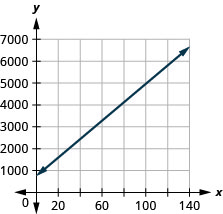
108. Costa is planning a lunch banquet. The equation [latex]C=450+28g[/latex] models the relation between the cost in dollars, [latex]C[/latex], of the banquet and the number of guests,[latex]g[/latex].
a. Find the cost if the number of guests is [latex]40[/latex].
b. Find the cost if the number of guests is [latex]80[/latex].
c. Interpret the slope and [latex]C[/latex]-intercept of the equation.
d. Graph the equation.
Exercises: Use Slopes to Identify Parallel Lines
Instructions: For questions 109-134, use slopes and [latex]y[/latex]-intercepts to determine if the lines are parallel.
Solution
parallel
Solution
parallel
Solution
parallel
Solution
parallel
Solution
parallel
Solution
parallel
Solution
parallel
Solution
parallel
Solution
parallel
Solution
not parallel
Solution
not parallel
Solution
not parallel
Solution
not parallel
Exercises: Use Slopes to Identify Perpendicular Lines
Instructions: For questions 135-146, use slopes and [latex]y[/latex]-intercepts to determine if the lines are perpendicular.
Solution
perpendicular
Solution
perpendicular
Solution
not perpendicular
Solution
not perpendicular
Solution
perpendicular
Solution
perpendicular
Exercises: Everyday Math
Instructions: For questions 147-154, answer the given everyday math word problems.
147. Slope of a roof. An easy way to determine the slope of a roof is to set one end of a [latex]12[/latex] inch level on the roof surface and hold it level. Then take a tape measure or ruler and measure from the other end of the level down to the roof surface. This will give you the slope of the roof. Builders, sometimes, refer to this as pitch and state it as an “[latex]x\;12[/latex] pitch” meaning [latex]\frac{x}{12}[/latex], where [latex]x[/latex] is the measurement from the roof to the level—the rise. It is also sometimes stated as an “[latex]x[/latex]-in-[latex]12[/latex] pitch”.
a. What is the slope of the roof in this picture?
b. What is the pitch in construction terms?
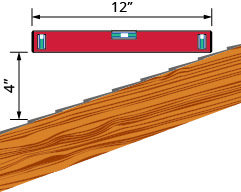
Solution
a.[latex]\frac{1}{3}[/latex]
b. [latex]\text{4 12 pitch}[/latex] or [latex]\text{4-in-12 pitch}[/latex]
Solution
[latex]\frac{3}{50}[/latex]; [latex]\text{rise}=3[/latex], [latex]\text{run}=50[/latex]
150. Highway grade. A local road rises [latex]2[/latex] feet for every [latex]50[/latex] feet of highway.
a. What is the slope of the highway?
b. The grade of a highway is its slope expressed as a percent. What is the grade of this highway?
151. Wheelchair ramp. The rules for wheelchair ramps require a maximum [latex]1[/latex]-inch rise for a [latex]12[/latex]-inch run.
a. How long must the ramp be to accommodate a [latex]24[/latex]-inch rise to the door?
b. Create a model of this ramp.
Solution
a. [latex]288[/latex] inches ([latex]24[/latex] feet)
b. Models will vary.
152. Wheelchair ramp. A 1-inch rise for a 16-inch run makes it easier for the wheelchair rider to ascend a ramp.
a. How long must a ramp be to easily accommodate a 24-inch rise to the door?
b. Create a model of this ramp.
153. The equation [latex]n=4T-160[/latex] is used to estimate the number of cricket chirps, [latex]n[/latex], in one minute based on the temperature in degrees Fahrenheit, [latex]T[/latex].
a. Explain what the slope of the equation means.
b. Explain what the [latex]n[/latex]–intercept of the equation means. Is this a realistic situation?
Solution
a. For every increase of one degree Fahrenheit, the number of chirps increases by four.
b. There would be [latex]-160[/latex] chirps when the Fahrenheit temperature is [latex]0^\circ[/latex]. (Notice that this does not make sense; this model cannot be used for all possible temperatures.)
154. The equation [latex]C=\frac{5}{9}F-17.8[/latex] can be used to convert temperatures [latex]F[/latex], on the Fahrenheit scale to temperatures, [latex]C[/latex], on the Celsius scale.
a. Explain what the slope of the equation means.
b. Explain what the [latex]C[/latex]–intercept of the equation means.
Exercises: Writing Exercises
Instructions: For questions 155-158, answer the given writing exercises.
Solution
When the slope is a positive number the line goes up from left to right. When the slope is a negative number the line goes down from left to right.
Solution
A vertical line has [latex]0[/latex] run and since division by [latex]0[/latex] is undefined the slope is undefined.
A geoboard is a board with a grid of pegs on it.
The rise of a line is its vertical change.
The run of a line is its horizontal change.
The slope of a line is [latex]m=\frac{rise}{run}[/latex]. The rise measures the vertical change and the run measures the horizontal change.
Lines in the same plane that do not intersect.
Lines in the same plane that form a right angle.
A negative slope of a line goes down as you read from left to right.
A positive slope of a line goes up as you read from left to right.
The slope of the line between two points (x1,y1) and (x2,y2) is [latex]m=\frac{y2-y1}{x2-x1}[/latex]
The slope–intercept form of an equation of a line with slope m and y-intercept, (0,b) is, y=mx+b.




